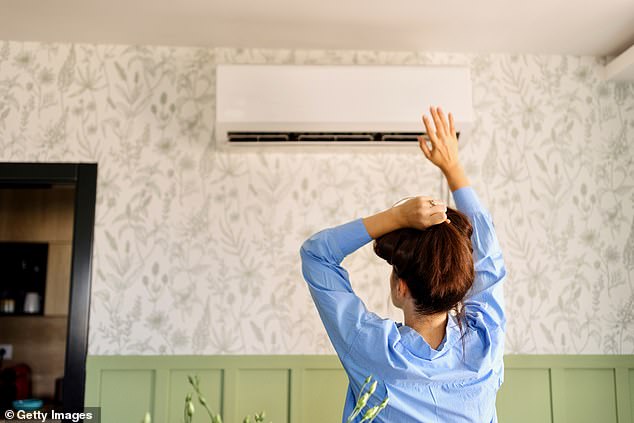If you are experiencing unexplained headaches, cough and runny nose, dizziness, or fatigue with no known culprit, you may want to inspect a common appliance.
Air conditioning is one of the most popular modern conveniences, protecting against heat waves and filling homes with fresh air.
But, if units are not properly installed, maintained, or cleaned, they can become plagued by mold, causing serious health complications for unsuspecting residents who breathe their air.
Tony Abate, indoor air quality expert and vice president of AtmosAir Solutions, told DailyMail.com: ‘Dirty air conditioning units, especially those filled with mold, can certainly affect your health… (and) spread mold and other contaminants within a room.’
In many cases, air conditioning units become contaminated with black mold, which typically grows where there is moisture due to water damage, water leaks, condensation, or flooding.
The Cleveland Clinic reports that black mold triggers an immune response and people can experience exacerbated allergies and develop symptoms such as sneezing, coughing, congestion and eye irritation.
Shu Saito, founder and CEO of filtration and HVAC company All Filters, said DailyMail.com: ‘Dirty air conditioners and those infested with mold create health risks primarily through compromised indoor air quality and the unit acting as a continuous source of airborne contaminants.
‘If an air conditioning unit is not properly maintained, the dust, dirt and moisture that accumulates on its surface can serve as an ideal environment for mold growth. Once mold has taken hold, spores are released into the air whenever the system is in operation and can cause everything from a variety of respiratory problems to skin irritation, increasing the severity of asthma and allergic reactions.
In many cases, air conditioning units become contaminated with black mold,
He continued: “These spores, along with other system contaminants such as bacteria and dust mites, can cause problems ranging from minor nasal blockages and sneezing to more serious conditions such as bronchitis, chronic coughs or even sinus infections in people. who have compromised immune systems.’
For most people, exposure to black mold will not cause serious illness or death.
However, for people with weakened immune systems, exposure to black mold can cause mycosis, a fungal infection throughout the body that causes fatigue, muscle aches, chest pain, weight loss, and asthma-like symptoms.
Other types of mold that can commonly grow in air conditioning systems include alternaria (green or brown with a velvety texture) and chaetomium (cotton-like appearance with a musty odor).
If mold grows in your air conditioner, you may notice a musty smell or see black spots around the unit.
If you suspect that an air conditioning unit is contaminated, you can contact specialists to have it analyzed.
The cost of performing a contamination test on an air conditioning unit can vary depending on the type of test and the system being tested, but RPF Environmental notes that the average is around $400.
For those on a budget, DIY test kits are inexpensive ways to inspect the air quality in your home initially and can cost between $15 and $200.
Air conditioners with moisture buildup, poor ventilation, moldy vents and ducts, as well as units that are not used frequently, can spread contaminants into the air that people unknowingly breathe.
Glenn Gault, CEO of Gault Heating & Cooling, explained: “What air conditioning units do is draw air from the room, cool it, and then return it to the room.
‘When room air enters the air conditioning unit, it passes through a filter that removes many particles, such as dust and mold spores, before flowing over the cooling coils.
“If mold spores grow on the coils or other internal parts of an air conditioning unit, they can be expelled with the air, reducing indoor air quality and posing a major health threat.”
And Mr Saito added: ‘These problems are worse in homes or structures that are not well ventilated because these types of pollutants become trapped inside and continue to recirculate.
“Due to this repeated exposure, the membranes of the airways become chronically inflamed, weakening the body’s immune response and therefore making it more prone to infections.”
Confirming Mr. Saito’s claims, Autumn Clayman, 29, of California, said mold in her apartment’s air conditioning unit left her with “burns” on her skin and a $10,000 bill to replace her belongings. and move.

Autumn Clayman Claims Black Mold in Her Apartment’s Air Conditioning Unit Caused Skin Irritation
She began experiencing a burning sensation around her face and began seeing red marks on her skin shortly after moving into her new apartment in Los Angeles in February.
Then she started developing eczema (chronic inflammation and itching of the skin) all over her body and her allergies got worse.
Not sure what was causing her problems, Ms. Clayman eliminated certain foods to see if things would improve, but they didn’t.
However, Clayman’s seizures worsened and she believed the cause was something in her apartment. So, she stayed at her boyfriend’s house for two weeks. While there, his symptoms began to ease.
Feeling certain that it was her house that was causing the problems, Ms. Clayman paid $780 to have her apartment tested for mold and it came back positive for stachybotrys chartarum – or black mold – in her two air conditioning units, which They had been blowing cold air throughout the apartment.
Air conditioning repair provider Smedley’s says the best way to prevent black mold buildup in your air conditioning unit is to clean the evaporator coil annually.
Cleaning experts note: “Encased within the air conditioning plenum, the evaporator coil is kept damp and dark – perfect conditions for mold to flourish.”
It’s possible to clean the evaporator coil yourself with a mild detergent and warm water, but “you risk damaging the fragile aluminum fins that line the evaporator coil.”
Therefore, it would be best to hire a technician.
Other tips experts offer are draining and cleaning the condensate drip pan, changing air filters every three months, and investing in a stand-alone dehumidifier to help curb mold growth.
They also recommend UV germicidal lamps, which can be installed near the evaporator coil and other places that are a hotbed for mold growth.
Long-term use of UV germicidal lamps “not only combats existing mold growth, but also plays a role in preventing future mold, fungus and bacteria growth.”
If your air conditioning unit can’t be stored, it might be worth purchasing a new one, with window, wall-mount, and freestanding models available. Prices range from $150 to $600, depending on deals.
Overall, Saito highlighted that proper maintenance of air conditioning units is crucial to maintaining a cool and healthy home: ‘In addition, mold growth and dust accumulation overload the HVAC system, degrading its performance, resulting in high energy costs.
“Regular cleaning and replacement of system filters is vital not only to keeping systems running but also to ensuring the health and well-being of everyone in the environment is protected.”


